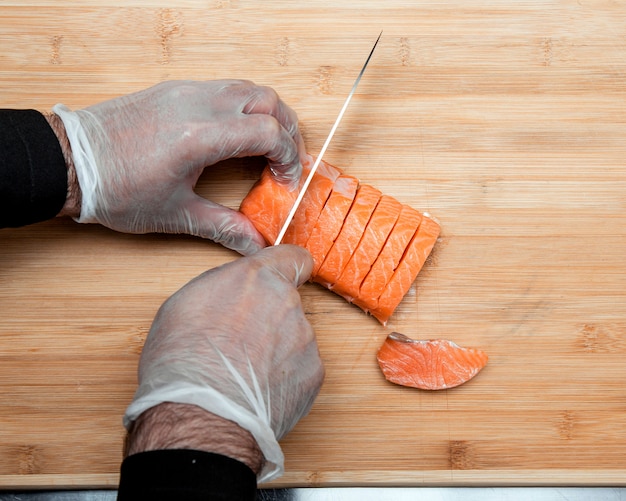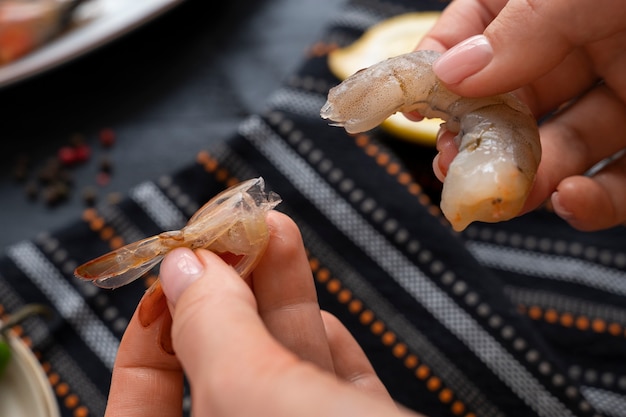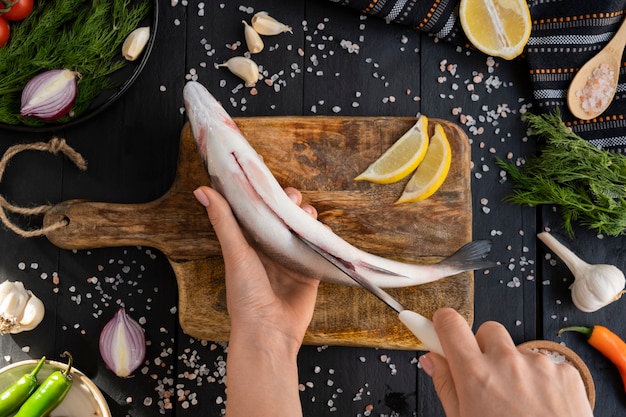It's a classic dilemma: You've got a bag of beautiful, fresh shrimp, ready to transform into a delicious meal. But then, that nagging question pops up: "How long do I cook them for?" I've been there more times than I care to admit, staring at a pan full of these delicate crustaceans, wondering if I'm about to overcook them into rubbery, flavourless sadness. I've learned the hard way that shrimp are notoriously sensitive to heat, and a few extra minutes can make all the difference between a culinary triumph and a textural disaster. So, let's dive into the world of shrimp cooking time, unravel the mysteries, and get you on the path to shrimp perfection.
(Part 1) The Shrimp Essentials: Anatomy and Cooking Methods

Before we jump into specific cooking times, let's get a grip on the basics. Understanding the anatomy of a shrimp is vital, like knowing your way around a car before you hit the road. It's all about appreciating the different parts, how they affect cooking, and how to prepare them for the best results.
Shrimp Anatomy 101: From Head to Tail
Think of a shrimp like a tiny, edible, swimming package. Here’s a breakdown of its key components:
- Head: The pointy bit at the top. It's often removed before cooking, mainly for aesthetic reasons. Some folks love the head, especially in dishes where it adds extra flavour, but I usually give it a miss.
- Shell: This tough outer layer protects the shrimp. It’s usually left on for cooking, adding a more robust, slightly briny flavour. If you're aiming for a delicate, melt-in-your-mouth texture, you can peel the shell before cooking, but be prepared for a more subtle flavour profile.
- Vein: This dark line runs down the back. It’s the shrimp's digestive tract, and while perfectly edible, it can be a bit off-putting for some. Removing it is purely for aesthetics, and if you’re feeling adventurous, you can leave it in for extra flavour (though I admit I haven't tried it!).
- Tail: The tail is the end part. It's often left on for eating as it adds a bit of visual interest, but feel free to remove it if you prefer a streamlined presentation.
- Meat: This is the star of the show, the succulent, juicy, flavourful part we all crave. The cooking time is directly influenced by the size of the shrimp and the cooking method you choose.
Common shrimp cooking methods: Your Options for Perfection
There are so many ways to cook shrimp, each offering unique texture, flavour, and presentation. Here's a quick rundown of the most popular methods, and we'll dive into their specific cooking times later:
- Pan-frying: This is a classic for achieving a crispy exterior and a juicy interior. It's quick, easy, and perfect for a weeknight meal.
- Grilling: This method introduces a lovely smoky flavour and char marks, perfect for a summer barbecue. It also creates a beautifully caramelized exterior, which I absolutely adore.
- Baking: If you're looking for a fuss-free, oven-friendly option, baking is your best friend. It's great for large batches of shrimp and allows you to focus on other elements of your meal.
- Boiling: A simple and straightforward way to cook shrimp, perfect for adding to soups, stews, or making a quick and easy shrimp salad.
- Sautéing: Similar to pan-frying, this method involves quickly cooking shrimp in a pan with butter or oil. It's a great way to get a flavorful, slightly caramelized shrimp dish with minimal fuss.
(Part 2) Shrimp Shopping: Choosing Your Perfect Catch

Now that you've got a handle on the basics, it's time to go shopping! Knowing how to choose the right shrimp is crucial for ensuring a delicious and successful outcome. Here's what to look for when you're at the fishmonger or seafood counter:
Understanding shrimp size: A Matter of Numbers
shrimp sizes are often indicated by the number of shrimp per pound. The larger the number, the smaller the shrimp. It’s like a reverse size chart!
- 16/20: These are tiny little shrimp, often used in stir-fries or as garnishes. They're quick to cook and add a delightful burst of flavour.
- 21/25: These are the everyday shrimp, a good all-rounder for grilling, pan-frying, or baking. They offer a good balance of size, flavour, and texture.
- 26/30: These are larger shrimp, ideal for grilling or baking. They're perfect for showcasing their natural flavour and hold up well to bolder seasoning.
- 31/40: These jumbo shrimp are real showstoppers, ideal for grilling or broiling. They offer a substantial piece of shrimp with a sweet and succulent flavour.
Freshness Matters: The Signs of a Great Catch
Just like any other seafood, fresh shrimp are key for a delicious meal. Here are a few tricks to pick out the best:
- Firm and Springy: The shrimp should feel firm and springy to the touch. If they’re soft or mushy, they’re probably not fresh.
- Perky Color: The flesh should be a translucent, pearly white. Avoid shrimp that are discolored or have a greyish hue.
- Sweet and Mild: Fresh shrimp have a mild, sweet smell. If they smell fishy or ammonia-like, it’s best to steer clear.
- Keep It Cold: Always store shrimp in the refrigerator until you’re ready to cook them. Keep them cold to preserve their freshness and flavour.
(Part 3) Shrimp Cooking Time: A Detailed Breakdown

Alright, now for the moment you’ve been waiting for: the actual shrimp cooking time! Remember, these are general guidelines. Your actual cooking time will vary depending on the size of your shrimp, the cooking method, and your preferred level of doneness. But don’t worry, I'll guide you through each step with confidence.
Pan-frying: For a Crispy Crust and Tender Interior
Pan-frying is my go-to for achieving that perfectly crisp exterior and succulent interior. For medium-sized shrimp (21/25), I aim for 2-3 minutes per side.
Here's how to do it: Heat a tablespoon of oil in a pan over medium-high heat. Season your shrimp with salt, pepper, and any other spices you like. Add the shrimp to the hot pan, making sure not to overcrowd it. Cook for 2-3 minutes per side, until they turn pink and opaque. The shrimp should be firm to the touch and no longer translucent.
Grilling: For Smoky Flavour and a Caramelized Crust
Grilling shrimp gives them a wonderful smoky flavour and those beautiful char marks that make them look so tempting. For medium-sized shrimp, I usually grill them for 3-4 minutes per side.
Here's how to grill like a pro: Preheat your grill to medium-high heat. Thread the shrimp onto skewers or place them directly on the grill. Cook for 3-4 minutes per side, until they turn pink and opaque. The shrimp should be firm to the touch and slightly springy.
Baking: For a Fuss-Free Oven-Friendly Option
Baking shrimp is the ultimate lazy chef's delight. It's so easy and requires minimal supervision, making it perfect for a busy weeknight or a weekend gathering. For medium-sized shrimp, bake them for 10-12 minutes.
Here's how to bake your shrimp to perfection: Preheat your oven to 400°F (200°C). Place the shrimp on a baking sheet lined with parchment paper. Season them with salt, pepper, and any other spices you like. Bake for 10-12 minutes, until they turn pink and opaque. The shrimp should be firm to the touch and cooked through.
Boiling: A Simple and Versatile Method
Boiling shrimp is a classic method for adding them to soups, stews, or making a quick and easy shrimp salad. For medium-sized shrimp, boil them for 3-5 minutes.
Here's how to boil your shrimp: Bring a large pot of salted water to a rolling boil. Add the shrimp and cook for 3-5 minutes, until they turn pink and opaque. Remove the shrimp from the water and serve immediately.
Sautéing: For Quick, Flavorful Meals
Sautéing shrimp is a fantastic way to get a flavorful, slightly caramelized shrimp dish with minimal fuss. It's ideal for weeknight dinners or quick lunches. For medium-sized shrimp, sauté them for 2-3 minutes per side.
Here's how to sauté like a chef: Heat a tablespoon of butter or oil in a pan over medium-high heat. Season your shrimp with salt, pepper, and any other spices you like. Add the shrimp to the hot pan, making sure not to overcrowd it. Cook for 2-3 minutes per side, until they turn pink and opaque. The shrimp should be firm to the touch and no longer translucent.
(Part 4) The Overcooked Shrimp Nightmare: Avoiding a Culinary Disaster
We've all been there: that moment of horror when you realize you've overcooked your shrimp. It's a tragic sight: rubber, chewy, and devoid of flavour. Not a pretty picture. So, how do you avoid this culinary catastrophe? Here's the secret to shrimp success:
The Pink and Opaque Test: Your shrimp doneness Guide
The easiest way to tell if your shrimp are cooked is to check their colour and texture. Cooked shrimp will turn pink and opaque. This means they will be firm to the touch and no longer translucent.
Avoiding Overcrowding: Space is Key to Even Cooking
If you overcrowd the pan, the shrimp will steam instead of cook, leading to a mushy texture. Make sure you have enough space in the pan for the shrimp to cook evenly. If needed, cook in batches to ensure optimal results.
The Thermometer Test: For Precision Cooking
For extra peace of mind, use a meat thermometer. Shrimp are cooked when they reach an internal temperature of 145°F (63°C). This ensures they’re cooked through without overcooking.
Less is More: Don't Overwhelm Delicate Flavours
Shrimp have a delicate flavour. Sometimes, less is more. Too much seasoning can overpower the natural sweetness of the shrimp. A simple pinch of salt and pepper is often all you need.
(Part 5) Shrimp Inspiration: Recipes to Get You Started
Now that you're a shrimp cooking pro, it's time to get creative! Here are a few simple and delicious recipes to inspire your inner chef:
Garlic Butter Shrimp: A Classic for a Reason
This recipe is easy to make, always a crowd-pleaser, and bursting with flavour.
- Ingredients:
- 1 pound of shrimp
- 2 tablespoons of butter
- 2 cloves of garlic, minced
- 1/4 cup of white wine
- Salt and pepper to taste
- Fresh parsley for garnish
- Instructions:
- Melt the butter in a pan over medium heat.
- Add the garlic and cook for 1 minute, until fragrant.
- Add the shrimp and cook for 2-3 minutes per side, until pink and opaque.
- Pour in the white wine and bring to a simmer.
- Cook for 1 minute, until the sauce thickens slightly.
- Season with salt and pepper to taste.
- Garnish with fresh parsley and serve immediately.
grilled shrimp Skewers with Mango Salsa: Summertime Perfection
This recipe is perfect for a summer barbecue, combining the smoky flavours of grilled shrimp with a bright, refreshing mango salsa.
- Ingredients:
- 1 pound of shrimp
- 1 ripe mango, diced
- 1/2 red onion, diced
- 1/4 cup of chopped cilantro
- 1 tablespoon of lime juice
- Salt and pepper to taste
- Instructions:
- Thread the shrimp onto skewers.
- Preheat your grill to medium-high heat.
- Grill the shrimp for 3-4 minutes per side, until pink and opaque.
- While the shrimp are grilling, combine the mango, red onion, cilantro, lime juice, salt, and pepper in a bowl.
- Serve the shrimp skewers with the mango salsa.
shrimp scampi: A Classic Italian Delight
This classic Italian dish is bursting with flavour and remarkably easy to make. The combination of garlic, white wine, and Parmesan cheese creates a truly delicious sauce that perfectly complements the shrimp.
- Ingredients:
- 1 pound of shrimp
- 2 tablespoons of olive oil
- 4 cloves of garlic, minced
- 1/4 cup of dry white wine
- 1/4 cup of chopped fresh parsley
- 1/4 teaspoon of red pepper flakes
- Salt and pepper to taste
- 1/4 cup of grated Parmesan cheese
- Spaghetti or angel hair pasta, cooked according to package directions
- Instructions:
- Heat the olive oil in a pan over medium heat.
- Add the garlic and cook for 1 minute, until fragrant.
- Add the shrimp and cook for 2-3 minutes per side, until pink and opaque.
- Pour in the white wine and bring to a simmer.
- Add the parsley, red pepper flakes, salt, and pepper.
- Cook for 1 minute, until the sauce thickens slightly.
- Stir in the Parmesan cheese.
- Serve over the cooked pasta.
(Part 6) Shrimp cooking techniques: Beyond the Basics
Now that you've mastered the fundamentals, let's explore some more advanced shrimp cooking techniques to elevate your skills to a whole new level. These techniques will add depth and flavour to your shrimp dishes, transforming them into truly extraordinary culinary creations.
Shrimp Deveining: A Matter of Aesthetics
deveining shrimp involves removing the dark line running along the back, which is the shrimp's digestive tract. This is purely for aesthetics and doesn’t affect the flavour. However, some find it visually unappealing, so if you’re serving your shrimp in a presentation-focused dish, it's a good idea to devein them.
To devein shrimp, use a sharp knife to make a shallow cut along the back of the shrimp. Gently lift the vein out with the tip of the knife or your fingers.
Shrimp Brining: Plumping and Flavor Infusion
Brining shrimp is a technique that involves soaking them in a saltwater solution before cooking. This helps to plump up the shrimp and make them more flavorful. The salt draws moisture from the shrimp and then redistributes it back into the flesh, resulting in a juicier and more tender shrimp.
To brine shrimp, mix 1 cup of salt with 4 cups of water. Submerge the shrimp in the brine for 30 minutes, then pat them dry before cooking.
shrimp marinade: A Flavor Infused Feast
Marinating shrimp is a great way to infuse them with additional flavour before cooking. This is particularly helpful when grilling or pan-frying shrimp, as it helps to lock in moisture and create a more flavorful exterior.
To marinate shrimp, combine your favorite ingredients, such as citrus juice, herbs, spices, or soy sauce, in a bowl. Add the shrimp to the marinade and let them sit for 30 minutes to an hour. The longer you marinate, the more intense the flavour will be.
(Part 7) Shrimp Cooking Time: FAQs
Let's tackle some common questions about shrimp cooking time.
1. How long do I cook frozen shrimp?
Frozen shrimp usually take longer to cook than fresh shrimp. If you’re pan-frying, grilling, or baking, add 1-2 minutes to the cooking time. If you’re boiling frozen shrimp, cook them for 5-7 minutes. Remember, it’s always better to err on the side of undercooking rather than overcooking. Check for doneness using the "pink and opaque" method.
2. What happens if I overcook shrimp?
Overcooked shrimp become tough and rubbery. They also lose their sweet flavour and become less appealing. The texture can become unpleasantly chewy, and the flavour can become bland and rubbery.
3. Can I cook shrimp in a microwave?
Yes, you can cook shrimp in a microwave. However, they may not have the same texture as shrimp cooked by other methods. The microwave can sometimes result in a less appealing texture, with a tendency for the shrimp to become a little rubbery. For best results, use a microwave-safe dish and cover it with plastic wrap. Cook on high for 1-2 minutes, until the shrimp are pink and opaque. Check for doneness and adjust cooking time as needed.
4. How do I tell if shrimp is bad?
If the shrimp smell fishy or ammonia-like, or if they have a slimy texture, it’s best to discard them. You should also avoid shrimp that are discolored or have a greyish hue. It’s better to be safe than sorry when it comes to seafood freshness.
5. How long can I store cooked shrimp?
Cooked shrimp can be stored in the refrigerator for 3-4 days. To store cooked shrimp, place them in an airtight container and refrigerate them immediately after cooking. This helps to prevent bacterial growth and maintain their flavour and texture.
(Part 8) Shrimp Cooking Time: Conclusion
There you have it - the ultimate guide to shrimp cooking time! Whether you’re a seasoned chef or a newbie in the kitchen, this guide has everything you need to cook shrimp to perfection. Remember, the key is to pay attention to the size of the shrimp, the cooking method, and the doneness of the shrimp. And don’t be afraid to experiment - there’s a whole world of shrimp recipes waiting to be explored! So go forth, my fellow food enthusiasts, and cook some amazing shrimp dishes. Happy cooking!
Everyone is watching

Corn on the Cob: The Ultimate Guide to Perfectly Cooked Ears
Healthy MealsAh, corn on the cob. Just the name evokes images of sunny days, barbecues, and that sweet, juicy flavour that ...

Perfect Pork Roast Oven Cooking Time: A Guide to Delicious Results
Healthy MealsThere's something truly satisfying about a perfectly roasted pork. The aroma alone is enough to make your mout...

Scallops: The Ultimate Guide to Perfect Cooking
Healthy MealsAh, scallops. Those delicate, sweet, and utterly delicious morsels of the sea. They hold a special place in my...

Spaghetti Squash: The Ultimate Guide to Cooking and Serving
Healthy MealsRemember that time you saw spaghetti squash at the supermarket, looking all bumpy and strange, and thought, "W...

Ham Cooking Time: How Long to Bake, Smoke, or Boil a Delicious Ham
Healthy MealsAh, ham. It's a classic, isn't it? A real crowd-pleaser, especially around holidays. And when done right, it'...
